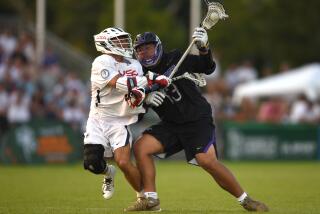For the U.S., a haul-mark performance
When speedskaters Brian Hansen, Jonathan Kuck and Chad Hedrick finished the team pursuit “A” final early Saturday afternoon, they could pat themselves on the back for winning a silver medal and officially start the U.S. chest-thumping for making history.
Theirs was the 35th medal for Team USA in the 2010 Winter Olympics, one more than its record 34 at Salt Lake City in 2002. Steve Holcomb’s four-man bobsled team added another later Saturday, the first U.S. gold in the sport since 1948.
“As an athlete, with everyone focusing on the medal count, you obviously pay attention,” said Apolo Anton Ohno, the three-time Olympian whose three short-track speedskating medals here gave him a career eight, most for a U.S. winter athlete.
“To know this is the biggest medal haul ever is pretty amazing.”
The United States will top the medal count for the first time since 1932, and it will finish with 37 medals, breaking the single-country record of 36 set by Germany in 2002.
Canada also has made history, leading the gold-medal count for the first time.
Even the International Olympic Committee is celebrating the U.S. success, which also is amazing given the fractious IOC relations with the United States in the last decade.
“If the U.S. comes first by whatever count, they will claim a victory, and that would be good for them and the Olympic movement,” IOC President Jacques Rogge said.
As noteworthy as the U.S. achievement is in its simplest mathematical terms, it is even more impressive when a number of other factors are added to this Olympic differential equation.
And the results show how far the United States has come since its dismal six-medal showing in 1988 (the last time the Winter Games took place in Canada), thanks to what became a two-phase plan to improve U.S. performance.
Phase 1 was the equivalent of putting a brace on a badly injured knee. Phase 2 was reconstructive surgery and rehabilitation.
From winning a worst-ever 4.3% of the available medals at the 1988 Calgary Olympics, the U.S. has won 14.2% of the Vancouver medals with just five outstanding.
That defuses any argument that the U.S. medal total is inflated by the number of new events since 1988.
So does this: 17 U.S. medals have come in events also on the Calgary program. And only one medal has come in an event added since 2002.
“Thus says our athletes were well-prepared, and we had a fantastic Games,” said Scott Blackmun, the U.S. Olympic Committee’s chief executive.
That preparation began even before the U.S. team had left Calgary with just two gold, one bronze and three silver medals, all in figure skating and speedskating.
The 1988 Winter Games still had five days to run when New York Yankees owner George Steinbrenner, then a USOC board member, blustered into town to head up a commission that changed the USOC’s previously vague mission into one that made medals the bottom line.
The 1989 Steinbrenner Commission report would start Phase 1 of an athlete performance plan that began with short-term support and long-term ideas: more money in the year before an Olympics, along with health insurance, part-time jobs and tuition grants that would allow athletes to compete longer.
Within four years, the U.S. had upped its percentage of medals. It improved a bit more at the 1994 Games in Lillehammer, Norway, before backsliding slightly at Nagano, Japan, in 1998.
Bill Demong competed at his first of four Olympics in Nagano, finishing 34th in the Nordic combined individual event. Last week, he became the first U.S. gold medalist in the sport.
“In Nagano, we felt like a small country,” Demong said. “As a whole team, we felt like one of the outsiders. And now we’re here to win.”
Olympic kayak champion Norm Bellingham, the USOC’s chief operating officer, has been involved in the development programs since 1988. He said a desire to have a “respectable medal total” at the Salt Lake City Games led to a change in philosophy that is a major factor in the Vancouver results.
“I don’t think anyone ever perceived one-year programs would be sufficient,” Bellingham said. “They needed to be seven- or 10-year programs, because the time it takes for an athlete identified as podium potential to reach the podium typically is eight to 10 years.”
Demong, who will carry the U.S. flag in the closing ceremony, and his sport are the prime examples, benefiting from increased USOC funding and the long-term plan the U.S. Ski and Snowboard Assn. was asked to develop in the mid-1990s for Nordic combined.
“The way we got to where we are is by taking it every step of the way,” Demong said. “We kind of earned it before we got here.”
The USOC gave $40 million in winter athlete support over the four years leading to Salt Lake City. The support was $55 million in the four years leading to Vancouver.
That will be a challenge for the USOC after 2012, given the recession and questions over how much money it will get from as-yet undetermined U.S. television rights for 2014 and 2016.
“The USOC has an unbelievable saying: ‘It’s not every four years, it’s every day,’ ” Ohno said. “I’d like to think that future generations, Sochi (2014 Winter Olympics) and beyond, will receive whatever they need to be their absolute best at the Games.”
The bar for absolute best now is very high.
More to Read
Go beyond the scoreboard
Get the latest on L.A.'s teams in the daily Sports Report newsletter.
You may occasionally receive promotional content from the Los Angeles Times.





